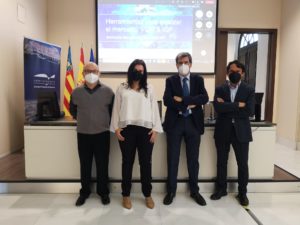
The president of the Port Authority of Valencia has indicated that the cycles are now more volatile and shortened in time.
In fact, between December 2018 and May 2021, the nominal freight rate of the China Containerised Freight Index has gone from 750 to 3,496, an increase of 465%.
Valenciaport has held the seminar to analyse the tools in the maritime market.
Maritime transport remains the most efficient and cost-effective system that fosters trade between nations while contributing to prosperity.
The Port Authority of Valencia (PAV) and the Valenciaport Foundation have held this Thursday the seminar “Tools to analyse the maritime market” with the aim of presenting the latest advances in statistical indicators such as indices to analyse freight rates or port connectivity that are available to the port community as tools of analysis to facilitate decision-making.
The president of the PAV, Aurelio Martínez, explained that “the main objective of all these indices is to try to interpret the evolution of the market in its broadest conception (freight, connectivity, efficiency…), and to anticipate as far as possible the decisions to be taken by the agents operating in it. For example, the freight market has always shown a significant volatility, pronounced depending on the type of goods transported, accompanying the global economic cycles, which since the 2008 crisis has seen a considerable shortening of these cycles”. In this sense, the president of the PAV has given the example of the China Containerized Freight Index (CCFI) that between December 2018 and May 2021, the nominal index of freight rates has gone from 750 to 3,496, an increase of 465%, while between 1998 and 2018 they fell by 20%, a sign that currently the cycles are more volatile and shortened.
“We currently have too much opinion and too little information based on objective data. For this reason, it is essential to rely on indices with a very elaborate methodology and objective data from recognised sources,” Martínez explained. According to the United Nations World Maritime Organisation, international maritime transport accounts for approximately 80% of world freight traffic. It remains the most efficient and cost-effective system and is the safest and most cost-effective means of international freight transport that promotes trade between nations while contributing to prosperity.
“This is why it is so necessary to have the tools to analyse this traffic to take into account all the variables and flows of the maritime sector, which is key to international relations. These indicators are key to making inter-sectorial and sectorial comparisons, identifying long-term trends and, above all, they help in decision-making”, Martínez added. In this sense, the APV demonstrates, once again, with the publication of periodic studies and indices, its commitment to providing regular and reliable information at the service of companies and the port community.
Tools for analysing the market
Following this line, Valenciaport has developed two indices to analyse the port market. On the one hand, the Valencia Containerised Freight Index (VCFI), which measures the evolution of containerised maritime export prices from Valenciaport. Amparo Mestre, director of Market Intelligence at the Valenciaport Foundation, has made a point of highlighting the behaviour of freight rates in 2020 and has argued that “growth responds to the interaction of supply and demand”. The second is the Port Connectivity Index (PCI), based on UNCTAD methodology, which analyses the supply of short sea shipping services.
The conference, moderated by the Director General of the Valenciaport Foundation, Antonio Torregrosa, continued with the participation of Vicente Pallardó, Professor of Applied Economics at the University of Valencia; Hercules Haralambides, Professor of Economics and Maritime Logistics at the University of Paris and Dalian Maritime University; and Jan Hoffmann, Head of the Trade Logistics Branch of UNCTAD. The speakers highlighted the importance of these reports for the port community and for the exporting/importing companies, which provide them with fundamental information on the evolution of the maritime market.
During his speech, Professor Vicente Pallardó explained that “the recovery funds, such as those of the EU to reactivate the economy after COVID-19, must serve to change the future. Therefore, those responsible for managing them must think about projects aimed at structural challenges, sustainable growth and new emerging sectors that generate economic activity and quality employment”.

